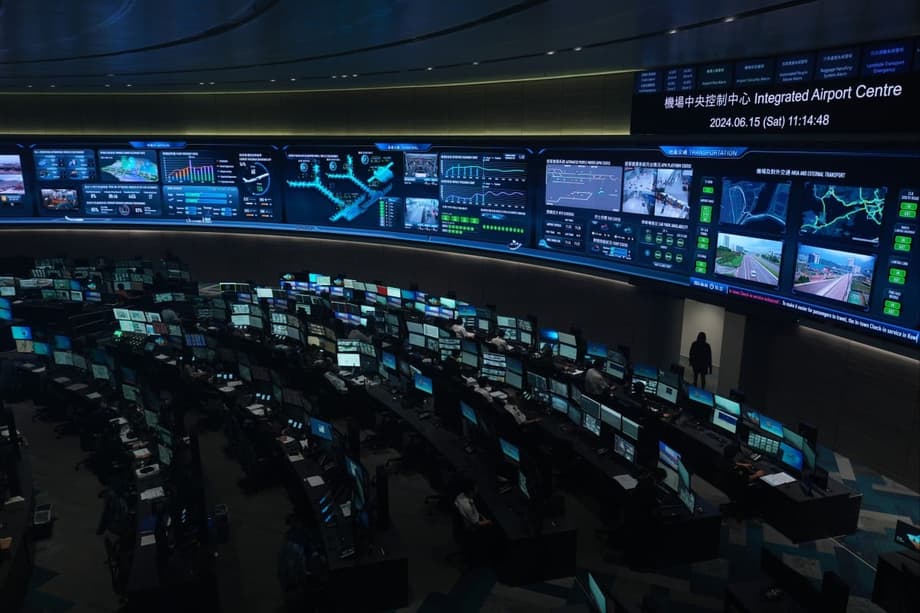Why US software controls matter for Hong Kong skies
Hong Kong’s aviation sector faces an immediate risk as Washington weighs sweeping restrictions on American critical software linked to China. The city’s airlines, airport systems, and maintenance providers depend on U.S. code for daily operations, from flight planning and avionics updates to engine health analytics and crew training. A clampdown would not necessarily turn off systems overnight, yet new licensing hurdles and access limits could slow updates, disrupt training schedules, and complicate safety procedures at one of Asia’s busiest aviation hubs.
- Why US software controls matter for Hong Kong skies
- What is being considered and how broad could it be?
- Why aviation runs on US software
- How US export controls bite
- Possible fallout for Hong Kong airlines and the airport
- Are there viable alternatives and workarounds?
- What regulators could still allow
- What companies in Hong Kong should do now
- Geopolitics and market reaction
- The Bottom Line
U.S. President Donald Trump has threatened new export controls on any and all critical software bound for China, a move tied to Beijing’s expanded restrictions on rare earths, key inputs for electronics, vehicles, and aerospace. Hong Kong, which the United States treats like mainland China for export control purposes, sits squarely within the scope of any broad software action. Technology advisers in the city are urging institutions to accelerate contingency planning. Aviation specialists warn that this is the sector where switching providers or going without updates is hardest, given stringent safety and certification requirements.
What is being considered and how broad could it be?
According to a U.S. official and people briefed by authorities, the package under discussion would curb shipments of items that contain U.S. software or were produced using U.S. software. That would extend beyond direct software downloads to a wide variety of products and services powered by American code. The scope, still under review, spans consumer electronics and highly specialized equipment used in aerospace. Some measures could roll out in coordination with Group of Seven allies.
U.S. Treasury Secretary Scott Bessent has indicated that the administration is looking at a range of options. He told reporters that no idea has been ruled out. After he addressed the issue, markets pulled back, underscoring how sensitive investors are to any tightening of technology flows between the two economies.
Introducing the broader policy debate, Bessent said it plainly.
“Everything is on the table.”
Some specialists caution that applying controls to software across many industries would be complex and carry commercial costs for U.S. firms. Emily Kilcrease, a former U.S. trade official now with the Center for a New American Security, framed the trade-off in stark terms.
“Software was a natural point of leverage for the U.S. Still, such controls would be extraordinarily difficult to implement and would lead to blowback for U.S. industry.”
Why aviation runs on US software
Commercial aviation is saturated with U.S. software, both visible and behind the scenes. Even when aircraft are built in Europe or serviced in Asia, many critical tools and data streams originate with American vendors or rely on U.S. intellectual property. Key dependencies include:
Flight planning and navigation data. Airlines schedule routes and optimize fuel using software suites that integrate navigation databases, weather, and airspace restrictions. Many carriers rely on U.S. providers for electronic flight bag charts and monthly navigation data updates. Without timely data, crews cannot fly certain routes or approaches.
Avionics and engine updates. Flight management systems, avionics suites, and engine control modules periodically require patches or configuration changes supplied by U.S. manufacturers and their partners. These updates can be essential for safety, reliability, and compliance with airworthiness directives.
Maintenance, repair, and overhaul. Digitally delivered manuals, service bulletins, parts catalogs, and troubleshooting tools underpin modern maintenance. Some of the largest knowledge bases, diagnostic algorithms, and predictive analytics platforms are developed or hosted by U.S. firms. Interruptions can delay repairs or ground aircraft that await digitally authorized fixes.
Airline operations and revenue systems. Scheduling, crew assignment, revenue management, and reservation platforms frequently involve U.S. code, either as complete products or as embedded modules. A license block or suspended access to cloud-hosted functions can ripple through on-time performance and customer service.
Training and simulation. Full flight simulators and training devices use software stacks that often include U.S. components, from flight models to visual systems. Licensing and content updates are part of recurrent training programs required for pilots and technicians.
Alternatives exist in some categories, particularly from European and Asian vendors. Yet migration is slow. Replacing core systems in aviation typically demands safety assessments, data migration, integration testing, revised procedures, and regulator acceptance. Even straightforward changes, like switching an airline’s chart provider, involve weeks or months of planning, updates to thousands of devices, and training for flight crews and dispatchers.
How US export controls bite
The U.S. regulates the transfer of dual-use items under the Export Administration Regulations (EAR). Software and technology that are U.S.-origin, located in the United States, or commingled above certain thresholds with U.S. content are subject to these rules. The Commerce Control List spells out what items require licenses for specific destinations and end uses. Controls can be based on national security, missile technology, nuclear proliferation, or other criteria.
Two long-standing pillars shape the reach of U.S. rules:
De minimis and foreign-direct product concepts. Foreign-made items that contain more than a de minimis level of U.S. content, or that are produced using specified U.S. software or technology, can become subject to U.S. jurisdiction for shipments to targeted destinations. Washington used these tools to curtail sensitive technology flows to Russia, Belarus, and specific Chinese entities.
Entity List and addresses of concern. The Bureau of Industry and Security (BIS) can restrict dealings with listed companies and, in some cases, with high-risk addresses used by shell companies that facilitate diversion. In 2024, BIS added multiple Hong Kong addresses to the Entity List as part of an effort to curb illegal transshipment, and it tightened controls on business and design software in separate actions targeting Russia and Belarus. Those steps show a willingness to apply software controls and to scrutinize Hong Kong-linked activity for diversion risk. The BIS announcement is posted on its website at bis.gov.
U.S. authorities also stress that foreign-based persons can be held liable for violating U.S. export controls when dealing in U.S.-origin items or in transactions involving sanctioned parties. A joint compliance note from the Departments of Commerce, Treasury, and Justice warns that penalties can be severe and encourages robust internal controls and due diligence by non-U.S. businesses that handle controlled software and technology.
Possible fallout for Hong Kong airlines and the airport
In aviation, timing is everything. Many safety and operational processes depend on frequent software and data refresh cycles. A tighter licensing regime or platform access restrictions could have very practical effects:
- Navigation data cycles. Airlines update navigation databases on a 28-day cycle. If access to U.S. data services is blocked or delayed, crews may be unable to fly certain procedures or use new airspace design, leading to cancellations or reroutes.
- Avionics and engine patches. Delayed firmware or configuration updates can trigger maintenance deferrals. When those updates are tied to airworthiness directives, aircraft can be parked until a fix is installed and verified.
- Predictive maintenance. Engine health monitoring relies on analytics platforms, often hosted in the cloud by U.S. providers. If data ingestion or software licensing is restricted, airlines lose early warnings that help avoid in-flight shutdowns and expensive unscheduled maintenance.
- Training continuity. Simulators and training courseware must be updated on a regular schedule. Licensing or content blocks could push back crew qualifications or force temporary reliance on fewer devices.
- Operational planning and customer impact. If scheduling or revenue systems are affected, check-in, rebooking, and crew management can seize up during irregular operations. A small outage can cascade into a day of delays.
Hong Kong International Airport’s air traffic systems and airport community tools also interface with a range of vendor platforms. Many are European or local. Yet message switching, cybersecurity tools, and monitoring layers often include U.S. software. Even when a product is built outside the United States, embedded modules or development tools may be American, which is where foreign-direct product rules can complicate exports and updates.
Are there viable alternatives and workarounds?
Some substitutions are possible. European providers offer navigation charts and flight planning, and there are non-U.S. reservation and operations platforms. Air traffic management systems from European vendors are widely deployed in Asia. These options, however, are not drop-in replacements. Switching providers requires contracts, integration, data conversion, comprehensive testing, pilot and dispatcher training, and sign-off by regulators and safety managers. During transition, airlines often run two systems in parallel to manage risk.
Another constraint is jurisdictional overlap. Even if a replacement product is built and hosted outside the United States, it may incorporate U.S. code or have been built using American design software that comes under the EAR. Vendors that are not U.S. companies still tend to follow BIS guidance if their products could be pulled into U.S. jurisdiction, to avoid penalties. Parallel moves by allies can reinforce that caution. The United Kingdom, for example, requires export licences for controlled goods, software, and technology to Hong Kong under its strategic trade controls and maintains an arms embargo on the territory.
Limited stopgaps exist. Airlines can store some data locally, prepare contingency procedures for paper backups, and front-load certain updates. Yet none of these measures scale well for long. Aviation safety relies on recurring updates and tightly integrated software chains. Partial workarounds help for days or weeks, not months.
What regulators could still allow
Policy makers have options if they want to narrow the collateral impact on civil aviation. BIS can tailor controls through licensing policies that distinguish between military and civil uses or that prioritize safety-of-flight considerations. Regulators can approve specific transactions with end-use and end-user assurances. They can also stage in restrictions to give operators time to switch or to apply for licences.
Even with such relief valves, compliance friction matters. License applications take time. Vendors often suspend service while they evaluate their exposure and seek guidance. Airlines then need to adjust schedules and maintenance plans during the gap, which can reduce reliability and add cost.
What companies in Hong Kong should do now
Aviation companies can reduce risk by preparing for tighter software controls and stricter compliance reviews. Practical steps include:
- Map every U.S. software dependency. Inventory avionics, engines, EFB tools, flight planning, training, maintenance, cybersecurity, and back-office systems that involve U.S. code or U.S.-hosted services.
- Engage vendors early. Ask software providers to outline how they will handle license requirements, updates, cloud access, and support if controls tighten.
- Line up licensing pathways. Where feasible, prepare license applications with clear statements of civil end-use, end-user information, and safety rationales.
- Test alternatives. Pilot a secondary chart or flight planning provider, build data migration plans, and validate training and operational impacts.
- Strengthen compliance. Update sanctions and export control policies to reflect extraterritorial reach. Train staff, monitor counterparties, and document due diligence.
- Stage critical updates. Where allowed, accelerate planned patches and data refreshes to build a buffer before rules change.
The Tri-Seal compliance note makes clear that foreign-based entities can face serious penalties for violations. That leaves airlines, maintenance providers, and airport partners with a dual objective, maintain flight safety and continuity while ensuring that every step meets U.S. legal requirements.
Geopolitics and market reaction
Trade tensions are again steering technology policy. China’s expanded rare earths licensing regime disrupted global supply chains, and Washington’s answer is to tighten access to U.S. software, a strategic lever that Washington sees as central. Negotiators from both sides continue to meet, yet the hardening stance around software and critical materials raises the stakes as leaders prepare for a bilateral summit.
Financial markets have already reacted to the prospect of broader software controls. U.S. indices fell after reports of the plan, with technology and airline shares under pressure. Futures markets remained cautious, reflecting concerns about guidance from big tech firms and the risk of fresh restrictions that would hit cross-border technology flows.
Beijing signals resistance to unilateral measures. After the U.S. floated software restrictions, a spokesperson for the Chinese embassy criticized the approach and promised countersteps if needed.
“China opposed the US imposing unilateral long arm jurisdiction measures and vowed to take resolute measures to protect its legitimate rights and interests if the US proceeds down what it views as a wrong path.”
That exchange illustrates why Hong Kong sits in a tough spot. The city’s aviation ecosystem is deeply global, built on hardware, software, and data that cross borders every hour. Even limited constraints on U.S. software could reshape procurement, training, and maintenance plans at airlines and at the airport for months to come. Planning now can soften the shock if the policy window narrows.
The Bottom Line
- Washington is weighing new export controls on critical U.S. software tied to China, and Hong Kong is treated the same for export control purposes.
- Aviation relies on U.S. code for flight planning, avionics and engine updates, maintenance data, training, and key back-office systems.
- Controls under the EAR, including foreign-direct product rules, can reach foreign-made items produced using U.S. software and technology.
- BIS has previously targeted Hong Kong-linked diversion risks and tightened controls on software in actions against Russia and Belarus.
- Airlines could face delays to navdata cycles, avionics patches, predictive maintenance analytics, and simulator updates.
- Alternatives exist in Europe and Asia, but switching is slow due to certification, integration, and training hurdles.
- Regulators could narrow impacts through licensing, yet compliance friction and vendor caution would still affect operations.
- Companies in Hong Kong should inventory U.S. dependencies, engage vendors, prep license filings, test backups, and strengthen compliance programs.
- Markets slipped on the prospect of tighter controls, while Beijing vowed to respond, underscoring persistent trade and tech tensions.




